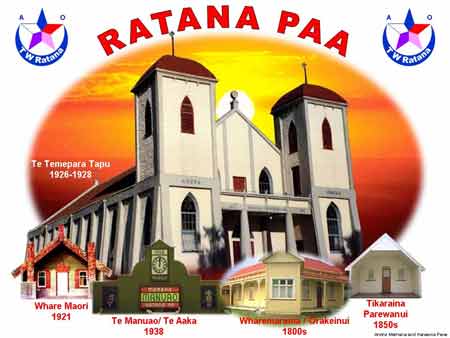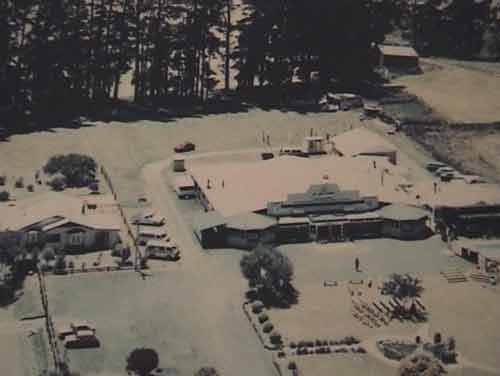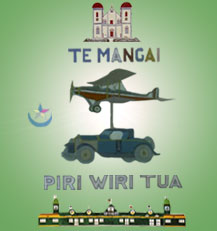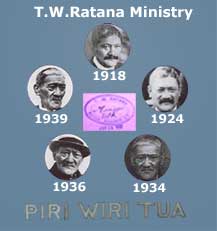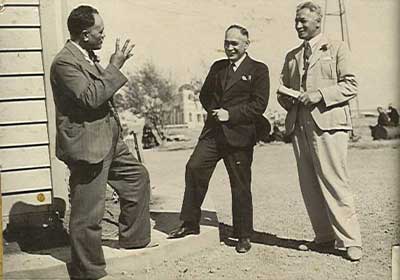

Home | E
T.W. RATANA
| Treaty of Waitangi | Kaupapa O Nga Koata | 1929 Ratana | 1930-1932
Tirikatene Enters Parliament | 1933 Period | 5th July 1934 | Piri Wiri Tua
Masters Thesis 2003: The information on this website is thoroughly researched and chronologically listed into historical categories from my Masters Thesis completed in 2003 titled, Last of The Great Phophets, Sacred Icons of the Ratana Movement and Ratana Church. All information sourced and gathered from the full set Te Whetu Marama O Te Kotahitanga 1924-2002, complete set Te Rongo Pai Hou A T.W.Ratana Mangai, full set Nga Akoranga, Uri Whakatupuranga Ratana Archive Research Centre, oral history, live documentary interviews. personal family diaries, unpublished manuscripts, hand written journals and old photo albums from the Morehu around New Zealand and those living in Ratana Pa. Information also sourced from newspaper clippings, hand written world tour journals 1924-25, old black and white films, world tour newpapers, Online web search Japan, Great Britian, United States America, Canada, Europe, South Africa, Pacific Islands, Australia, New Zealand.
(Spiritual Law)
The Ture Wairua (Spiritual Works of the Mangai) are the teachings its Principles, Doctrines in harmony with the Holy Bible, and on the one hand had to comply with the requirements of the law, aligning itself to its modern customs and usages, policies, guidelines; is known as the Ratana Established Church of New Zealand.
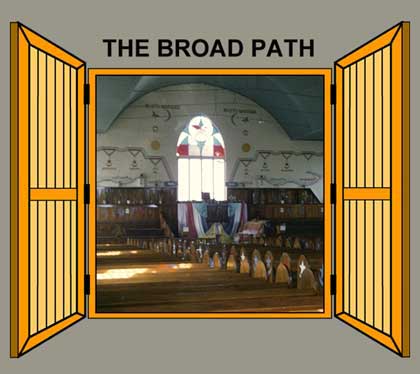
(Physical Law)
The Ture Tangata (Physical Laws, Piri Wiri Tua Campaigner, Nga Koata) has two Section B of the Ratana Church deals with the Tiriti o Waitangi, Te Mana Motuhake, of the Maori people and their concerns of their Land Claims, rights and privileges (Political) and as embodied in the Tiriti O Waitangi.
The Creed of the Ratana Movement and Church was signed by the original Apostles giving their appointment of Tahupotiki Wiremu Ratana as the Tumuaki was conveyed to the Registra General’s Office. One individual who supported Ratana and his work was Father Arthur John Seamer, who is remembered as a person who carried love and devotion and compassion for his fellowmen, was regarded as a counselor and a friend to Tahupotiki Wiremu Ratana, who was one time President of the Methodist Church. Father Seamer was a close friend and advisor right to the end, living with Ratana and his family whenever he visited Ratana Pa. On July the 15th 1925, the Ratana Established Church of New Zealand was registered with the Registrar General of Marriages Births and Deaths in Wellington; Tahupotiki Wiremu Ratana was appointed as Tumuaki (President), the head of the Ratana Church. The structure of the Ratana Movement and the Ratana Church combines within Jehovah’s Maramatanga, the Creed (Kaupapa o te Whakapono) that belongs to the Mangai and T.W.Ratana who signed the Registration of the Church. After the Church was registered with the Registrar General in Wellington on July 15th 1925, the move was made to register the Ture Tangata section during November 1925. This was to be known as the Kotahitanga. The Ture Tangata structure had two functions.
During the Hinota held in Piki Te Ora on 25th December 1925 T.W.Ratana (Mangai) spoke the following words:
“Ko taku tino pukapuka ko te Paipera Tapu, haunga nga himene nei; - engari to koutou tino taonga ko te Paipera anake.”
T.W.Ratana: “The most important book for me is the Holy Bible, these hymn books are one thing, but the Bible is our real Treasure.” (Editor WM Te Tai I, 1926: pg3)
“Ka whakapumautia ano te Paipera e te Mangai, i kii hoki ia – “E tino whakapono ana te Haahi Ratana ki te Paipera.”
In 1927, the Mangai again said “The Ratana Church truly believes in the Bible.”
8. “E whakapono ana ahau ki Te Paipera Tapu ara ki nga pukapuka katoa o Te Kawenata Tawhito, ote Kawenata Hou; Ko te paiheretanga i nga tino whakaaturanga nunui a Ihoa ki te tangata, mo te oranga pumau o tona wairua, me te oranga tinana ano hoki.”
8. “I believe in The Holy Bible, in both the New Testament and the Old Testament, for it is the record of Jehovah's greatest revelation concerning eternal life of the spirit and the vitality of the body.”
(Editor WM Te Tai, 1925: pg2; Akoranga Anaru: 1997; Registrar General Wellington: 1925)
One quote spoken by T.W.Ratana Mangai to his followers in believing in Jehovah, that in Jehovah would be their refuge and protection for all times, and guide in their walk of life.
“Takoto atu ki a Ihoa o nga Mano hei Kai Arahi mo koutou I nga wa katoa, I roto I a koutou mahi hikoi, whakaaro ano hoki I runga I te wehi, I te Pono, I te Tika ki mua I Nga Ariki hei whakapuawai I a mahi katoa”
“Abide with Jehivah Lord of Hosts who will watch over you always and guide yoi in your work, in your travels and in your thoughts; and in all your duties, proceed with reverence, in Faith and in truth before Jehovah, the Father, Son, the Holy Spirit, and their Faithful Angels, for thereby all your labour shall flourish and bear fruit”
These two Pillars are designed to work in harmony, however, the Maramatanga as a whole, was in the beginning called “Te Maramatanga O Ihoa” meaning the Light or Revelation of Jehovah of the Multitudes the Creator or the Author of life. However, over the years due to the loose nature of translating Maori words and names into English, the Maramatanga has now come to be known as the Ratana Movement. The founder decreed that these two components should not become completely separated from each other, but they were designed to complement each other, one side dealing with the Church affairs while the other dealt with matters of finances and business administration and operating in harmony for the benefit and betterment of our Maori people. Why did Tahupotiki Wiremu Ratana, Mangai think it so important to keep the spiritual works separated from the physical works, and how would they complement one another. In the book of Matthews Chapter 21 verse 12-13, Scripture tells us,
Verse 12 “And Jesus went into the Temple of God, and drove out all those who were buying and selling there. He overturned the tables of the moneychangers and the stools of those who sold pigeons”.
Verse 13 “And said to them, it is written in scripture that God said, my Temple will be called a house of prayer! However, you are making it a hideout for thieves”.
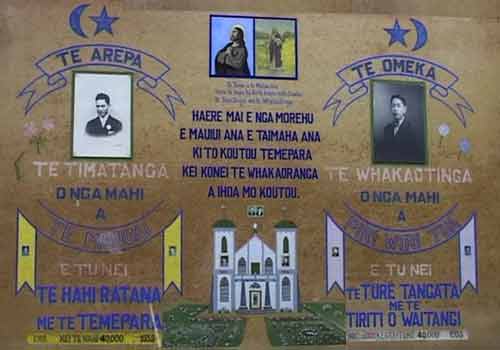
When Ratana left New Zealand in 1924, on his trip to the British Empire Exhibition, and to take his petition for the Tiriti O Waitangi, he went to England following the footsteps of kingi Tawhiao in 1884, and Kingi Rata in 1914. This indicated that Maori had be engaging with foreign delegates from other nations to test the Tiriti O Waitangi under international law compared to local law in New Zealand. While in England Ratana was told the New Zealand Government had sent a telegraph requesting he no mandate concerning the Tiriti o Waitangi. After leaving England he travelled through Europe and on to many other countries finally visiting Japan. Ratana was seeking for a nation to support the Maori peoples plight with the Tiriti O Waitangi who would stand with him in the League of Nations to speak on behalf of the Maori peoples grievances concerning the Tiriti O Waitangi. Ratana was told the problem is with your own New Zealand Government, which still continues today.
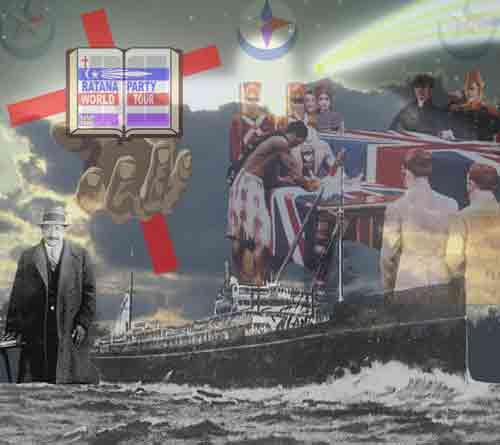
The relation between the Ratana Movement and the Labour party originally stems back to 1925, with the young vibrant Harry Holland a member from the newly formed Labour Party. Wiremu Ratana’s Aunt Mere Rikiriki his uncle Inia Ranganui, Rangi Mawhete saw a means for Maori to have a voice which the party seemed sympathetic to the Maori concerning the Treaty. By May 1927, with key components setup, Ratana was able to enter into the Ture Tangata (physical) aspect of his work, the political arena. This paved the way allowing him to investigate and implement his strategies for the ratification of the Tiriti o Waitangi, Mana Motuhake and rights and privileges to manifest for all Maori through Government Legislation. (Editor WM No.53 Te Tai I, March 28th 1925: pg20)
Tiriti
O Waitangi
The history of the Tiriti O Waitangi goes back to 1840, signed by Crown representatives with over
500 Maori chiefs. This remains a central issue in New Zealand today, which leaves
much division between Maori and Pakeha, and the Crown as it was in
1840s. The decision of the Crown to step in and resolve matters
was, to all intents and purposes, aimed at protecting the rights
of both the Maori people and the new settlers. There are many aspects
concerning the Tiriti O Waitangi that will come up for discussion, but first of all, let us look at two important points
that have caused great disappointment and anger among Maori and non Maori, as we view the facts about the Treaty of Waitangi. With the obvious mistranslation and interpretations of the Tiriti for
the Maori text which resulted in the official English version of the Treaty
of Waitangi being nowhere near what the Maori chiefs read, and understood,
after being presented with the crowns official version of the text was
an injustice and disgrace to Maori. By then Maori
found themselves enmeshed once the full impact of colonization was felt. (Akoranga Anaru, 1997: pg5)

T.W.Ratana (Piri Wiri Tua) Treaty of Waitangi petition was taken into the House of Representatives in Wellington (1932). His Treaty petition has never been presented or viewed by the New Zealand public, The Treaty has had a modifying influence on offical dealings with Maori people and more generally the New Zealand public attitudes, compared to the European of the 1800s, had a determination to dominate with colonial domination of indigenous races leaving the gap between Maori and European expectations of the Tiriti O Waitangi which still remains unbridged. After the signing of the Treaty of Waitangi at Waitangi by Captain William Hobson, seven copies of the Treaty of Waitangi document were sent around the country for signing. The Church Missionary Society press at Paihia, printed copies of the Treaty using one to obtain further signatures.
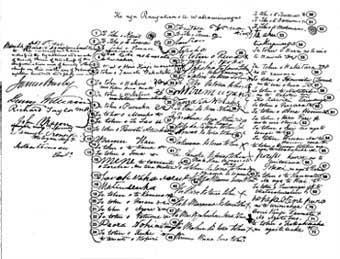
These documents were later moved to Wellington at the Colonial Secretary's Office. In 1841, fire burnt the government offices in Auckland, where the Treaty documents were held in an iron safe during 1865. These documents were moved to Wellington, at the Colonial Secretary's office. The government printed facsimile copies of the Treaty documents in 1877, and were put into storage. The Treaty lay dormant until 1911, when it was rediscovered and stored in the Wellington Government Building. Over a period of time water and rodents, damaged the original Treaty of Waitangi document, and the HMS Herald sheets. These documents were restored by the Dominion Museum in 1913, and then stored in specially constructed metal containers in the strong room of the Department of Internal Affairs.
The Treaty of Waitangi was on display for the first time to the New Zealand public in 1940, at Waitangi in the Bay of Islands during the Centennial celebration. The documents were loaned and displayed in 1949, by the Alexander Turnbull Library. In 1981, the Treaty of Waitangi was returned to Archives New Zealand with other important constitutional documents. In 1990, the Constitution Room at the new Archives New Zealand headquarters provided the conditions suitable for the permanent display for the founding sacred document of New Zealand the “Tiriti O Waitangi”. (A.R.Shearer: 1976)
During one of T.W.Ratana’s sermons in 1928, he said to his people
“As I stand here, the Mangai rests, and will abide in the Temple; my name henceforth shall be Piri Wiri Tua. I shall proceed to plough and till the earth, then turn the black soil up on the ground; then I shall dig deeper until I reach the red earth”. (Editor WM, June 1982: pg3)

The 1928, flag tells us that the “Mangai kei te Temepara”, and there forth comes Piri Wiri Tua the campaigner “Mo te Ture Tangata”. This special flag announced to the whole world that T.W.Ratana Mangai had transformed from the spiritual works, spiritual powers, that were endowed upon him were sent back to the spiritual world within the Temple. ( Flag hangs in the Rangimarie Manuao Building, Kara Banner)

T.W.Ratana then conveyed his message to the Morehu that his wairua mahi (spiritual work) was completed and that he would take up the mantle of the Ture Tangata; Piri Wiri Tua, releasing the Mangai back into the Temple.
T.W.Ratana once again delivered one of his most prophetic announcements to the Morehu:
English Translation
(T.W.Ratana)
“I therefore tell you now, I shall divide my “Body” into Four Quarters, and I alone shall put it together.”
“I tell you then, Maniapoto, and the rest of the people also, if the Maori people agree to or accept this dividing of my body for the sake of the Ture Tangata, listen to me, verily and without fail, the work concerning our land claims etc… will be completed in the coming year 1929.”
“Dividing of my “Body” into four quarters, if they refuse to accept one leader during the coming year, everything we live and hope for, our land, the Tiriti of Waitangi etc… will rot and moulder away, and likewise you, the Maori people will be lost. I am not talking about petty problems no, I mean the claims the whole of this land.”
“What I have done in the Ture Wairua up to now I did because of the demands of the Morehu for whom I have great compassion. But now that the Temple has been completed, the Church established and its entire works properly set out and planned, I feel free to devote my time to the Ture Tangata. That’s why I now tell you, I shall divide my body into four quarters, one quarter for Tai Tokerau, one quarter for the Tai Rawhiti, one quarter for the Tai Hauauru, and one for Te Waipounamu.” (Editor WM Paikea P, 1928: pg4; Akoranga, Anaru: 1997: pg39)`
Most sermons spoken by Piri Wiri Tua can be interpreted spiritually or physically. Did he refer that he would more or less dig up and over turn the black soil meaning he would cultivate the Ture Tangata works to gain back their settlements and benefits, rights and the privileges of the Maori people, as embodied in the Tiriti O Waitangi signed in 1840. Then he continues to say that he would dig deeper until he reached the red earth and refers to Abel and Cain from the book of Genesis, where Cain’s anger, creed, jealousy and land grabbing, therefore he killed his brother Abel. This in comparison relates to Maori people where their land was wrongfully taken and the land was soaked in blood of our Maori men, woman and children, hence the red earth is referred to was soaked in blood of the Maori people”. (Editor WM: 1928; Editor WM, June 1982: pg3)
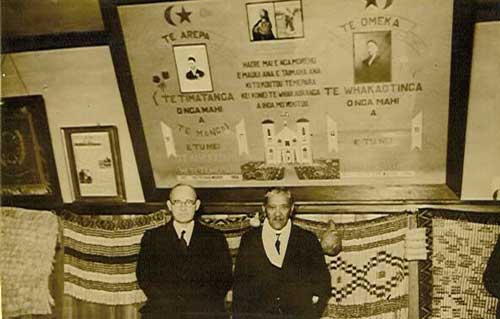
The physical mantle for Tahupotiki Wiremu Ratana, as the Campaigner would be know as Piri Wiri Tua; after his visit to Te Rere o Kapuni (Victoria Falls Taranaki). From 1928 through to 1932, Ratana T.W.Ratana Piriwiritua worked in the political realm of man.
This period of his ministry, he chose four men who would make up a team called the Four Quarters (Nga Koata E Wha). Tihema Eruera Tirikatene, Haami tokouru Ratana, Pita Turuki Moko and Paraire Paikea. He called his Nga Koata his children, he knew his members would be loyal to his Kaupapa, they would listen to him and the Maori people at all times work in the realms of love in their hearts.
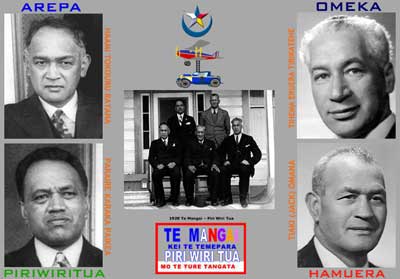
Maori Version: "Tena koe e taku tamaiti e Tia (short for Tiaki) ka inoi ahau ki a IHOA kia pai te tupu o tau maara kerepe, kia tu te waina ataahua ki runga ki tau teepu; ka hoatu e ahau ki a koe te kii o te raka o te tatau".
English Translation: "I greet you my son Tia.... I shall ask Ihoa that your vineyard will be fertile and that your grapes will flourish so that wine of the finest vintage will be set upon your table; I give you the key of the Lock of the Door.”
(Editor WM 20th October 1928; Akoranga, Anaru: 1997 Pg29)
Political Move Piri Wiri Tua
|
|
Political Move: The two main reasons why Ratana went ahead to recapture the lost treasures for Maori.
1) He was approached by Tupu Te Waharia on the matter of the Tiriti o Waitangi and what he called “Te Mauiui Oneone”, when he came to Ratana Pa, during his early part of his ministry on the 24th December 1920, to talk with Ratana. The efforts made by King Tawhiao, King Te Rata and T.W.Ratana to have the Treaty recognised by the British Government. (Akoranga Anaru, 1997: pg28) By May 1927, with key components setup, Ratana was able to enter into the Ture Tangata (physical) aspect of his work, the political arena. This paved the way allowing him to investigate and implement his strategies for the ratification of the Tiriti o Waitangi, Mana Motuhake and rights and privileges to manifest for all Maori through Government Legislation. On The 15th July 1927, T.W.Ratana prepared a trip to Waikato to visit King Rata and discuss issues concerning their “Taonga” (Tiriti o Waitangi), but unrest between the Waikato people and Ratana still abated his visit. After his trip of Tai Tokerau (Northland) the apparent reasons emerged between factions, this due to the bases of power, and who held the power in Maoridom. |
This did not deter Ratana away from travelling among the people and dealing with Church matters. Maori were crying out for ways and means of resolving their problems over their land. Ratana continued to speak out saying, if you the Maori people unite, your problems will be solved, and you will have no more problems with the Government and the issues of the Tiriti o Waitangi.
These are the main focal points that enabled Ratana to establish a foothold in Maoridom.
- The Maramatanga or fulfilment of the Prophecy in 1918
- The implementation of the Kotahitanga
- Ratana Movement
- Registration of the Ratana Church in 1925
- Registration of Ture Tangata Section (Kotahitanga) 1925
- Establishment of all Ture Tangata committees.
- Completion of the Ture Wairua (Spiritual law or works) (Akoranga Anaru, 1997: pg30)
The Ratana Movement appealed to the Maori people who were discontented with the Government system. As with the Ratana Movement now starting to spread throughout New Zealand Ratana tried to persuade the Pakeha MPs to accept his programme to revive social and cultural life within Maoridom. By this time Ratana was clear in his mind about what he would do to help the Maori people (King .M: 1988; Hagger A.R, Sacred Icons Ratana Movement and Ratana Church 2003)
T.W.Ratana turned his attention to organising the farming of the land in and around Ratana. His plan was to sow wheat, oats, barley, potatoes, kamokamo, as well as corn for the people. His work force consisted of cooks who feed the workers, and visitors, tractor drivers, lorry drivers, labourers for planting and sowing the crops, produces 37,000 bushels of corn in peak years, using 15 tractors, 300 young Maori have learned modern farming methods.

There were stable hands to take care of the horses, blacksmiths, boot makers and carpenters building new facilities. There were motor mechanics; you see the contingent of workers that were becoming part of the Ratana organization began to take hold as many Maori organizations throughout the New Zealand felt the full force of the Ratana Movement and Ratana Church.
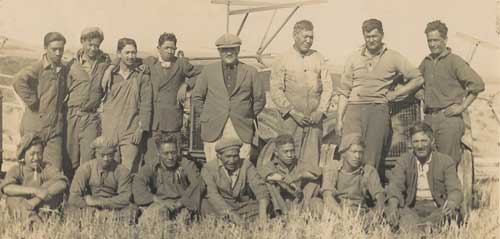
However, it wouldn’t be until October 1929, Piri Wiri Tua sent his Secretary to Wellington before the Royal Commission with reports on his wheat farming, which the secretary gave a brief account of the work being done on Ratana’s wheat farm. There were a 100 acres devoted for planting vegetables, and several acres were sown in barely and oats. Ratana was aiming at sowing 800 acres of wheat. Ratana had been given no assistance from the Government, when the chairmen heard this he directed the clerk to note this in his report. The chairman ended his proceedings by saying; Ratana’s wheat was of the highest grade in New Zealand making him NZ top Wheat Farmer.
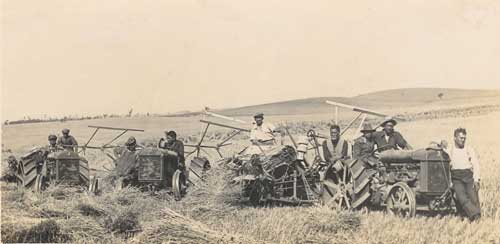
On the 7th July 1928, Ratana and his supporters travelled to Pakipaki, Hawkes Bay to attend the Tangi of Mohi Te Atahikoia. During their speeches one senior elder by the name of Mita Taupopoki of Te Arawa descent, rose to address and welcomed Ratana and his supporters. He referred to Ratana as the Mangai, complimented him on his work and the annihilation of Maori Atua (false Gods). He said that the Pakeha should take notice of Ratana’s work because they were unable to do away with the Atua Maori. The next speaker to address Ratana was Hori Tupaea Kahungunu descent, which addressed Ratana by saying that he represented all of Maoridom throughout the land.
When (T.W.Ratana) Piri Wiri Tua began to speak these were the words that were recorded by the Whetu Marama:
(Piri Wiri Tua) “The people of Tai Tokerau have petitioned that I stand for Parliament, and the people of Tai Hauauru and Te Waipounamu have done likewise. I am listening and waiting to see what the Tai Rawhiti people think.”
“When I say I shall divide my body, into four quarters, I mean that instead of me standing for Parliament, there should be four candidates, and those candidates shall be chosen by Piri Wiri Tua, in order that he may look into their hearts and be sure that they will do as he tells them.” (Akoranga; Anaru, 1997: pg36)
“E hara ma tetahi atu tangata hei tohu I aaku Koata, Engari maaku ano, kia Mohio ai ahau ka Whakarongo ratou ki aau, a, maaku ano hei tuitui paakete!”
“No one but I shall choose my Koata (4 members), as I want to be sure they will obey me; and I, myself will stitch up their pockets!” (Editor WM Paikea P, 1928: pp2-8)
| Mita Taupopoki rose to speak, turned to Ratana and said that he would pledge his support for Piri Wiri Tua, and he appealed to everyone on the Marae, to give great thought to the words of enlightenment that had been spoken by T.W.Ratana Piri Wiri Tua. A document from Apotoro Tihema Eruera Tirikatene arrived from Waipounamu (South Island) giving details of the decisions from the Morehu of Wairewa, Kaiapoi, Rapaki, Port Levy and Akaroa. The Morehu had given their support for Piri Wiri Tua as candidate or whomever Piri Wiri Tua may appoint. |
Treaty of Waitangi
September 1928, Ratana travelled back to Tai Tokerau Kaikohe, where he spoke to the people once again concerning the Tiriti, delivering the same message of kotahitanga, to unite as one under God. He told the people that he fears no man; his task was to deal with the Tiriti of Waitangi, that God had placed this Taonga in his hands. September 19th, four members for Parliament were selected too carry Piriwiritua policies or platform to the people with a special committee who would work along side these four chosen candidates. (Akoranga; Anaru, 1997: pg37)
In October 1928, T.W.Ratana, (Piri Wiri Tua) was invited to Taranaki, where we would visit Te Rere O Kapuni on Mount Taranaki. The editor of the Whetu Marama recorded this speech.
“A voice spoke from the within the Rere (waterfall) as follows
(Te Rere Kapuni) “Greetings to you Piri Wiri Tua, your coming here today will remind you of the saying which goes; Lift up your eyes to the hills, for there is your salvation. This is the Rere’ Tahupotiki Wiremu Ratana visited. Later, the Mangai came here, and now, Piri Wiri Tua has come. Tahu (Ratana) came here, and the work for which he was appointed is completed; the Mangai came here, and the work of the Mangai has been completed, the Church has been established, the Temple has been built, and the Apotoro, Pou O Te Haahi and Morehu have come into being.” “Today, Piri Wiri Tua has come. But it is the same “Body” that brought the Mangai that has brought Piri Wiri Tua here today. It is the same “body”, but there is a new spirit within. And the work to be done is also different”
“It has been confirmed, the Ture Tangata is now in the hands of Piri Wiri Tua. Jehovah of the Multitudes, will be your guide and protector and will be close at hand at all times. Piri Wiri Tua, I give into your hands the power and authority of the Ture Tangata. Do not be worried, or hesitant, and do not allow the taunts and criticism of the unbelievers to affect you and you work.” “Verily, your work will bear fruit within two years, and its conclusion will be confirmed at Geneva. But this will come to pass only if the Maori people are united with you. If so, your case will be heard in Wellington in June 1929, and in July and August 1929, in Geneva. Piri Wiri Tua, you are not permitted to stand as candidate for Parliament, as requested by the people. Instead you will work as a mediator among the people, and you shall be the one to lead them.” “The people of Taranaki and Waikato will give you trouble. However, you must be loyal to those who are loyal to you. The time will come when barriers will be erected between those who don’t support you and those who do.” (Editor WM Paikea P, 1930: pp7-8)
Ratana began to document his policies, which involved the problems of the land, before the signing of the Tiriti o Waitangi, and after the Tiriti was signed, to this present day. One of Ratana’s committee had the duty to investigate the many claims of the Maori people. By October Ratana was ready to announce his four chosen candidates for the coming elections. The message was broadcasted to all Morehu throughout the land, through the Whetu Marama.
KAUPAPA O NGA KOATA
He called his four candidates his children, who had worked along side him for a long time and who understood the principles associated with Government structures. They would be Independent candidates. His policy would consist of:
- Tiriti O Waitangi
- Te Mana Motuhake o te Iwi Maori
- Attention to the problems, claims etc, of the people both before and after the signing of the Tiriti o Waitangi
- Any other issues, and matters concerning Maori which the people were allowed to submit their aggrieves
This was printed in the Whetu Marama on the 20th October 1928. The four chosen candidates were; Haami Tokouru Ratana For Western Maori, Pita Te Turuki Moko For Eastern Maori, Paraire Paikea For Northern Maori and Eruera Tihema Tirikatene For Southern Maori.
Ratana had also setup a Management committee comprising of 10 members from each of the four Maori Electorates whose sole duty was to deal with all claims, and problems and matters affecting the Maori people. The scene was set for the Parliamentary Elections of November 1928, Piri Wiri Tua had spoken to the people throughout the land, the people had sent their petitions in support of Piri Wiri Tua and his four candidates, (Nga Koata), and it was on the 13th November 1928, the Elections were hosted.
However none of the Ratana candidates were successful at the polls, with Tirikatene losing by one vote. On the 24th November 1928 Piri Wiri Tua published the following report in the Whetu Marama. (Editor WM Paikea P, 1928: pg7)
(Piri Wiri Tua) “My greetings and salutations to all peoples, who live in these Islands. I want to thank those of you who supported me and my candidates at the recent General Elections.”
“You all know my candidates and I were not successful. However, what else can we say except this we tried, and failed. Thank you again for your support.”
“Greeting to the people of this land, both Morehu and non Morehu. My thanks to you who voted for your Candidates, Haami Tokouru Ratana, Te Turuki Moko, Paraire Paikea, and Eruera Tihema Tirikatene. Although they were not successful, we thank you for your support.”
“Although the results show that Tirikatene failed by one vote to unseat Te Tuiti Makitanara, we thank the people of southern Maori for their great support.”
“My greetings, then, to the people of the four winds who supported us in this venture. Piki Te ora to you all”
Your Servant Piri Wiri Tua
(Editor WM; Paikea P, 1928: pg7; Akoranga Anaru, 1997: pg40)
It would be Harry Holland from the new formed (Labour Party) who would make a visit to Ratana with Bill Veitch, a member from the (Liberals United) in December 1928, January 1929, hoping both parties could be helpful to Ratana and his mission seeing the Treaty of Waitangi being acknowledged concerning the rights and privileges for the Maori people be adhered too.
(Editor WM No.249 Te Tai I, December 29th 1928: Pg4)
However, history tells us leaders of these cults or movements, as they are often termed, are usually cast as prophets, leaders even called radicals, whose teachings, when observed, will facilitate the supremacy of their followers. The origins of religious doctrines by these prophets are in most cases due to a visitation from a supernatural. These principles are usually associated with a visitation from spiritual power as in the case with Tahupotiki Wiremu Ratana. With the obvious mistranslation and interpretations of the Tiriti O Waitangi document in the Maori text which resulted in the official English version of the Treaty of Waitangi being nowhere near what the Maori chiefs read, and understood. T.W.Ratana spoke on the Ratification for Tiriti o Waitangi, as God inspired him in many ways to bring these facts and place then before his people. He would simplify his speech in order for Maori to understand so they were able to visualize and see clearly the pathway to success or the pathway to failure. (Akoranga Anaru, 1997: pg5; Cox.L, 1993: pg117)
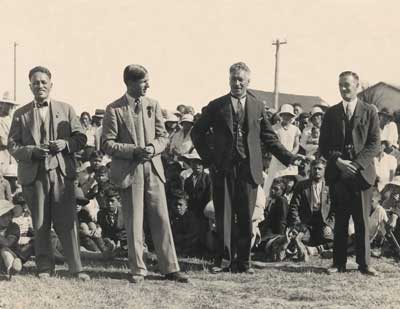
During Christmas invitations where sent to the following delegates from Parliament and Maoridom for the Hui being held in Ratana Pa. The visitors arrived, the Morehu were prepared for the Powhiri (Welcoming). The Government officials were the Hon Mr Veitch Minister of Labour and minister in charge of Pensions and Electoral Department who was accompanying him his wife and Tuiti Makitanara and his wife. Pepene Eketone, followed by Mr Ratana who greeted the distinguished visitors and welcomed all to his Marae, conducted the opening speech. Mr Ratana greeted the Hon Mr Veitch and gave his greetings also to the Prime Minister, the Rt Hon Ward who was unable to be present at their Hui. In Ratana’s main speech he said to Veitch with conviction and sincerity:
(T.W.Ratana) “I therefore give to you all of these matters as you and your Government have the medicine that will cure them all. Yes my friend, Mr Veitch, now that you have come here, let us work together on these matters. I therefore tell you all that I am willing to place myself, and the people who are loyal to me, together with all our remaining lands, under the care and direction of your Government. That is my wish because you extended the hand of friendship to us on this day. Let us work together. If you should receive a request for help from me, give it earnest consideration, and be ready to help me and my people.” (Editor WM 29th Paikea P, December 1928; Akoranga Anaru, 1997: pg42)
Mr Veitch endorsed Ratana’s speech by greeting the followers of the Movement and Church; he also expressed himself by saying, on Christmas day the day that Peace came upon Earth. He gave his condolences sympathy to the King of England who was gravely ill. Mr Veitch elaborated that the Labour Government would not deprive Maori of their lands, by quoting; Government policy is to help Maori people by making grants of money for the purpose of land development.
Veitch continued his speech expressing their Governmentknew the Maori people had suffered once the full impact of colonization had been established. Maori had been put through the trails of many injustices, but the Labour Government would be more lenient to Ratana and his Kaupapa. Piri Wiri Tua expressed his views to the Royal Commission that past Governments were wrong by inciting Maori to fight over their land, where by means, payment would be given for compensation for lands unjustly taken; He said, that is not what he wants.
Tuiti Makitanara Southern MP greeted Piriwiritua and the Morehu who where gathered on the Marae, by endorsing Mr Veitch speech
“Let me tell you this is the Government that will make your wishes come true. I endorse what the Minister said about government policy where Maori land is concerned’.
“We do not agree with the decision of the Royal commission. However, we totally agree with its findings, namely that it agrees that past governments were wrong in that they incited the Maori people in fighting over their lands. That is the most important, and satisfying part of the Commissions report. Therefore, where the payment of compensation for lands unjustly taken from the people is concerned, I say, no, that is not what we want. Don’t pay out any compensation, but wait a while, and give it more study”.
Tuiti Makitanara asked Ratana and his Morehu if they had any matters to put them before the Minister or the Government. Piriwiritua replied:
“Greetings we all know what we are seeking after and does Tuiti. I think it might be better for us to leave aside our important matters for now, and instead, place before them some small and easy matters for them to consider”.
Piri Wiri Tua referred that Ratana Pa is the biggest Pa in the whole of this land, but there is no water supply, and that their need for the railway station building to be moved and up graded to better location. They also required an official Post Office erected in Ratana, with many other issues being collated for future development. Hon Mr Veitch asked T.W.Ratana (Piri Wiri Tua) that these needs be written up and send to his Government, which he would refer to the Minister concerned.
(Editor WM Paikea P, 29th December 1928; Akoranga Anaru, 1997: pp43-44)
Ratana and his members drafted a proposal to present to the Prime Minister Joseph Ward that consisted of a new water tank to be built in Ratana Paa, this would assure Ratana if the Government could deliver the water tank they would be able to handle genuine claims legal issues given by many of the Maori tribes throughout the country. However, the water tank was never built, Ratana felt he needed a new political party who would support him and the Maori people in their most treasure gift ratifying the Treaty of Waitangi. However Tuiti Makitanara MP for the Southern Maori tried in vain to continue the relationship that Hon Veitch and Ward began with T.W.Ratana.
The Ratana Movement and Ratana Church appealed to the Maori people who were discontented with the Government system to support Ratana and his petition and sign his Kawenata (Covenant). As the Ratana Movement began to spread throughout New Zealand Ratana tried to persuade the Government MPs to accept his programme to revive social and cultural life within Maoridom.
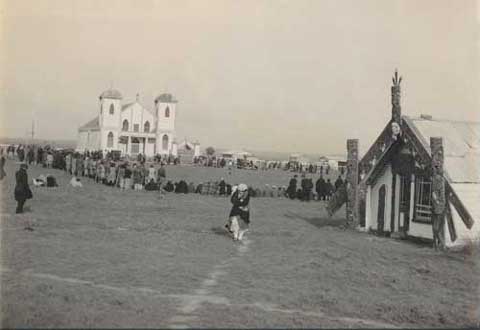
By this time T.W.Ratana (Piriwiritua) was clear in his mind what had to be done too make change for his Maori people, his immediate task was consolidating all Maoridom into one democratic voice using referendum (National Covenants and Petition) winning the four Maori seats at the November snap election that year. Ratana travelled extensively through the North and South Island campaigning and promoting his four selected members that would represent him and the Maori people in parliament. (Editor WM No.405-407 Te Tai I, December 26th–27th 2nd January 1932; King M: 1988)
T.W.Ratana sent his national petition asking “Is the Treaty dead or Alive”? This petition was sent throughout the country and had been signed by 38,000 Maori. T.W.Ratana (Piri Wiri Tua) asked all who signed his petition to vote for his four quarters (Nga Koata E Wha). However, the outcome was a disaster that reflected in the polling booths, 32,000 abandoned the campaign with the Ratana Independent Party Failing to win any seats, therefore, at the end of November 1928, T.W.Ratana hopes for Maori to unite began to fade he felt reluctant to represent Maoridom for Maori independence (Mana Motuhake) for their tribal claims, land confiscation for their grievances as embodied in the Tiriti O Waitangi. Ratana began to lean firmly towards representing his followers the Morehu (Remnants).
On January 29th 1929, Government delegate Te Tuiti Makitanara M.P brought the new legislation act passed recently by their Government to Ratana informing him, under their new legislation, Maori Land owners were entitled to set up a Board to administer their lands, that would entitle them to apply for Government loans, and that he would explained how the policy would benefit the Maori people.
T.W.Ratana (Piri Wiri Tua) explained the reason why compensation for payment of confiscated land would not be accepted, for it’s much easier to erase what is written on paper than to erase what is written in the Bible of your heart.
(Piri Wiri Tua) “My reason for saying the money should not to be paid was because I do not believe Five Thousand Pounds per annum would compensate for the blood that was spilt, and the blood of my Maori people! I say to you now, Te Tuiti, go ahead and pay them their money.” (Akoranga, Anaru: 1997, pg46)
On the 15th March 1929, an invitation was given to Ratana from Waikato, inviting him and his people to attend a Hui held at Ngaruawahia. On the agenda was the opening of their Whare Tupuna Mahinarangi, discussions on current affairs, with Maori leaders, Members of Parliament, Youth leaders and various Churches, would enable the them to make submission before the people. There would be a Maori Tennis Tournament being played between the discussions.
For ten years Ratana had tried in vain to get King Te Rata and his people to come to Ratana Pa. Speaking to the Morehu Piri Wiri Tua said that Apirana Ngata was rigging the Hui! If King Te Rata were arranging it he would be quite clear as to what he should say when confronted by their people. However it did not eventuate and Ratana decline the invitation. In Apirana Ngata speech he claimed that the work of Ratana’s ministry was Tohungaism, as Ngata said he and the Ratana people do not get on with each other.
But however in March 1929, the Rev A.J.Seamer arrived in Ratana where the congregation greeted him. While speaking to the people of Ratana he said I have just come from the Hui at Ngaruawahia and what struck him the most was the absence of the two greatest leaders of the Maori People, King Te Rata and Tahupotiki Wiremu Ratana, he continued by saying the meeting was controlled entirely by Apirana Ngata. Father Seamer commended Ratana for declining the invitation to the Hui. During the Easter Hui at Ratana 13,477 people signed the kawenata (covenant) supporting Piri Wiri Tua as leader in the work of the Ture Tangata.
During Ratana’s visit to Parliament his meeting with the Prime Minster Joseph Ward, T.W.Ratana and Apirana Ngata meet for the first time. In their conversation Ngata said I am willing to bury the hatchet, and think we should look to helping each other. As Ngata continued to speak he said that he would be prepared to recommend that assistance be given to Ratana and that the Maori Trustees were under his jurisdiction and that money would be available for such cases as Ratana’s.
The Prime Minister said that there were no problems about granting a loan, and that was the reason for the Secretary of Treasury to be part of their meeting. After this brief encounter T.W.Ratana (Piri Wiri Tua) shock hands with the Prime Minister and Apirana Ngata.
As Ratana turned to leave, Ngata asked him when was he was travelling back to Ratana Pa, but as Ngata was still busy shaking hands with the rest of the people, Ratana quietly slipped away from the congregation and made his way out of the house as the clocks of Wellington chimed on the hour of noon. May of 1929, Ratana began to elect his members for the Committee of Finances for the Kotahitanga, there were 45 members elected to represent the people, with Ratana sitting as President. (Akoranga Anaru, 1997: pg51)
During Christmas the Hon Mr Veitch attended the Hui dealing with matters of the Treaty of Waitangi. Ratana wanted to know why there was so much friction between him and the Department of Maori Affairs. Mr Veitch explained that this was news to him, he would personally pursue the matter but in all means the Government has good and peaceful disposition towards him and the Maori people. Mr Veitch commented that the Treaty was still alive and it is the document of Queen Victoria, and should be recognised. Through the Treaty your ancestors and ours were united as one nation. There were over 5000 people present on the Marae to present their policy to Piri Wiri Tua and the Government. Their policy agreeing that the people throughout the land would unite and be known as the “United Assembly for the Rights and Privileges of the Maori People” as embodied in the Tiriti o Waitangi. The assembly would collect information concerning injustices suffered by Maori, by the acts of successive Governments that dishonoured the Tiriti o Waitangi as followers:
- Land confiscated by force prior 1840
- Land purchased unfairly after 1840
- Land taken by Government, (Taranaki, Waikato, Tauranga Opotiki, Hawke’s Bay)
- The Government Land confiscation law
- The Public Works Act
- Rating and Tax Laws
- Maori Fishing Rights
- Maori Rights to Rock and other Oyster types
- Removal of sand, shingle, from lakes, rivers, and sea shores
- River Mouths and Habours
- Beds of river and lakes
- Land taken for schools
- Lands taken by the Churches.
(Editor WM; Paikea P, 1929: pp4-5; Akoranga Anaru, 1997: pp44-45)
At the end of 1929 the newly elected members of the Kotahitanga were announced and confirmed. During 1930 Ratana visit to Te Rere O Kapuni reveals that a second World Tour to revisit Geneva and the United Nations concerning the Treaty of Waitangi would be required.
1930-1932 Period
In 1930, T.W.Ratana assumed the role as Piri Wiri Tua and travelled to Mount Taranaki, Tere O Kapuni. As the water flowed down the waterfall, Piri Wiri Tua stood there listening to the voice echoing from inside the waterfall. The people who were gathered with T.W.Ratana Piri Wiri Tua heard him speaking and listening to the voice from in side the waterfall.
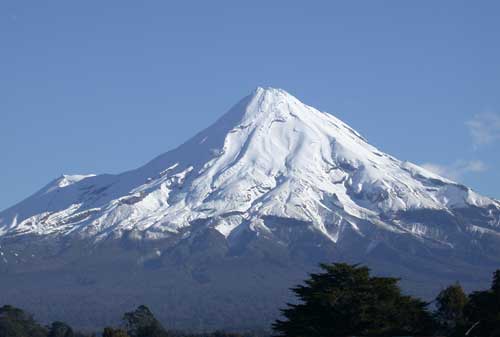
The voice in the waterfall speaking to Piri Wiri Tua
(Te Reo) “E Haere mai koe Piri Wiri Tua ki te aha”
(Voice in the waterfall) “Piri Wiri Tua you have come here for what”
(Piri Wiri Tua)
(Piri Wiri Tua) “I have come in regards concerning the Tiriti O Waitangi so that I may receive the benefits the fruits”.
(Te Reo) “Ae Piri Wiri Tua ko te Tiriti O Waitangi ko takahia ko ngaro"
(Voice in the waterfall)
As soon as the voice from the waterfall finished talking, Piri Wiri Tua turned around and spoke these words

(Piri Wiri Tua)
E Nga Anahera Pono, e haere mai a hou kia whakaarahia kia hurahia, Ko te Paipera me te Tiriti kei roto ite kapua teringa, ko whaka kaupapa tia enga Iwi o te motu ta ratou nei kaupapa, hei whakaraa I te Tiriti O Waitangi. Noreira patae, hei pai ranei kei roto hei kino ranei.
Piri Wiri Tua, turned around, called out to the Faithful Angels
(Piri Wiri Tua) “I Piri Wiri Tua have come here to resurrect and unfold the Tiriti O Waitangi. The Holy Bible and the Treaty of Waitangi I have in the palm of my hand. It has been all stored here and brought here by the nations to resurrect the Tiriti O Waitangi; therefore I ask is there any good in it”.
(Piri Wiri Tua) “My body is getting tired and weary because of the stubbornness of our people, therefore I have to ask the question, what is the way in which this will be fulfilled how would it be fulfilled, and where shall I go”.
The voice in the waterfall (future prophecy)
“Yes you must cross the great ocean the nations the Islands for there they are waiting for you”. (Editor WM Paikea P, 1930)
1835 the Declaration of Independents
1840 The Treaty of Waitangi
1884 King Tawhiao goes to England
1914 King Rata goes to England
1924 Ratana goes to England for grievance on the Tiriti O Waitangi
1925 Te Haahi Ratana Established
Piri Wiri Tua and his members began to prepare for the 1931, elections set for the 1st December organising his four Candidates (Nga Koata) representatives for Parliament. Several Hui were held at Ratana Pa that were attended by Tribal leaders, well-known Europeans from around New Zealand and Maori Politicians.
On the 26th February 1931, Piri Wiri Tua greeted the people on the Marae, he began his speech and thanked the 35,000 people who signed his Kawenata of support for the coming elections in December. He also greeted the people from Waikato, who were represented by Tupu Taingakawa who was a staunch supporter for Ratana. As they talked the debate continued between the Ministers of Parliament and T.W.Ratana (Piri Wiri Tua) concerning of ratifying the Tiriti o Waitangi and to restore their Mana Motuhake of the Maori people. Piri Wiri Tua spoke out saying that it wasn’t the Government of England that killed the Tiriti, but he accused the Government in Wellington. He spoke out by saying the Government and their members won’t come to Ratana because they are afraid and would be embarrassed by the barrage of questions the people would hurl at them. He even stated that Ngata has never been to his Marae yet, the invitation was offered to him.
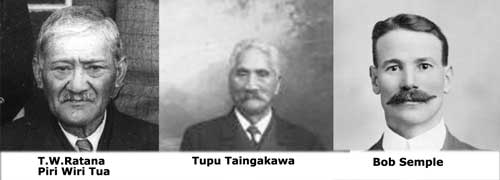
The guest speaker the delegate from the Labour Government Bob Semple began to address the large congregation gathered around the Marae, and offered his apologies for the absence of their Leader Mr Holland who was unable to attend due to commitments. He continued to speak saying the Labour Party agrees that the Treaty of Waitangi is a sacred document an agreement between Queen Victoria and the Maori People who sealed it with their own blood, that the present Government should uphold the articles of the Treaty of Waitangi for the benefit of the Maori people. He continued to say that past Governments have dishonoured the Treaty that all candidates should pledge themselves to uphold the Treaty of Waitangi. The Labour Party has always recognised and respects the Treaty of Waitangi. He concluded his speech by saying, Ratana, we the Labour Government will support you when you come to Parliament with your petition.”
(Editor WM; Tane, 1935: pp2-3; Akoranga; Anaru: 1991)
In 1931, T.W.Ratana bought forward another flag called Ringa Poto, Ringa Kaha. This flag depicts the well-known kupu from T W Ratana’s aunty Mere Rikiriki Ropea a famous female prophetess from Parewanui, Bulls. She stated that the one who would set the Maori people free from superstition would be a young man who would come bearing two books and he would dispense Jehovah’s judgment both directly (Ringa Kaha) and without favour (Ringa Poto).

These flags hang in the Rangimarie of the large rooms in the Manuao. They have been on display since 1993 and but unfortunately these flags and banners have suffered from moisture and dampness damage.
By August, Ratana began to prepare his campaign for the General Election, which he thrust all his energy behind his four Candidates. The four Candidates for the 1931, election are:
Many letters of support were sent to Ratana, and also letters from the opposition critics of his four candidates, from one gentleman in particular by the name of Tomoana, who wrote saying remove your representatives from the list of Candidates for Eastern Maori, and show some respect for Ngata. Of course they were all Apirana Ngata supporters. Ratana’s reply to that particular gentleman was:
(Editor WM Paikea P, 1931: pp1-9; Akoranga, Anaru, 1997: pg64)
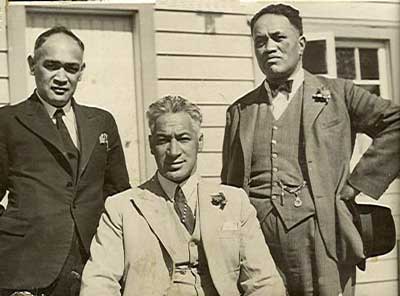
By the time the Election day arrived there was a total of 38,000 Maori who signed the covenant, pledging their support for Piri Wiri Tua and his Nga Koata. However, when the 1931, December election came about, from a total of 38,000 supporters who signed the sacred covenant only 6391 people honoured their pledge, the remaining 31,609, dishonouring their sacred pledge of that covenant.
(Piri Wiri Tua) “The fight is over” The Maori people have decided that I and my Koata, should fall, and also that the Tiriti O Waitangi and our Mana Motuhake should fall.” (Akoranga, Anaru: 1997, pg65)
Piri Wiri Tua spoke and He stated that his work in the Ture Tangata concerning the Treaty of Waitangi and the Mana Motuhake was over, and that Piri Wiri Tua will return back to the Mangai. In closing his speech to the people on the Marae he said the greatest Sin the Maori people have ever done was dishonouring their sacred pledge. (Covenant)
During 1932, Ratana took another petition seeking for the Tiriti to be entered into the statue books of the Dominion and into the constitution of the Dominion of the British Empire. This was in order to protect the special relationship between the Tangata Whenua the Maori people, and Pakeha. Ratana took up the mantle of Te Mangai once again travelling around New Zealand administering healing and annihilating Tohungaism. It during the 1932, Christmas Hui Apotoro Mete Keepa from Te Kao, handed a petition to T.W.Ratana to reconsider his decision on the Ture Tangata platform. The few who did honour the covenant were still keen to get behind Piriwiritua, in support for the ratification of the Treaty and their Mana Motuhake. (Editor WM Paikea P, 1932: pp2-3)
The petition was tabled during the January hui and left in the hands of T.W.Ratana whether or not Piri Wiri Tua and his 4 members would take up the challenge once again regarding the Treaty of Waitangi. Many of the Members of Parliament and their entourage who came to Ratana Pa were still envious and jealous of the work being done by Ratana. Numerous rumours surfaced that Ratana wanted to take the kingship role off King Te Rata, so the people of Waikato refused to vote for his Candidates. (Editor WM Paikea P, 1932: pp2-3)
Ratana put his petition together for the Maori people seeking for the Tiriti O Waitangi to be written into the statue books of the Dominion the constitution of Parliament and law. This would allow the Tiriti to be the governing foundation document for New Zealand in order to protect the relationship between Pakeha and Maori and Crown. The comment spoken by Ratana that Te Rata should remain King and he remain the Prophet, and the work of a Prophet is to show the way the King should move. At this time of his mission T.W.Ratana was becoming tied of carrying the people, his thoughts were back in the Ture Wairua work, the welfare of Maori and the Government were imposing great burden upon him. As he told the Morehu he will not be returning to the work of the Ture Tangata, but will hand it over to Piupiu Te Wherowhero a Maori representative and prophesised this words (Editor WM Paikea P, 1932: pp2-3)
” (Akoranga Anaru, 1997: pg67)
He referred back to Piupiu that he should uphold the law and the policies and always remember that he would be here that the 38,000 people, who are his supporters, are now under you Piupiu in the work regarding the Treaty of Waitangi and the Mana Motuhake. Ratana suggested that Piupiu should bring Te Rata to Ratana to shelter under his house, and if he were to unite with him, he too would have support of the people under his kaupapa! His position of Kingship would then be enhanced and strengthened. Piri Wiri Tua carried the works, and the results have been displayed before the people of this land, he commented in detail that if Te Rata is not careful he might be fooled and mislead by the work of the Government; if that happens they are finish. The Maori people who dishonoured their pledge to support Piri Wiri Tua should be crucified, they should be required to sign a covenant of repentance, in which they admit and confess their wrongs.
(Akoranga, Anaru, 1997: pg65)
March 1932, Mr Holland Leader of the Labour Party with the leader of the opposition had confirmed they would be present at the Ratana Easter Hui. A special council was set up to document all claims, ancestral lands and reserves, as well as matters relating to the Treaty to be submitted before the Labour Government. Ratana had always known that the previous Governments spent so much effort to suppress and deny the rights for Maori. The secret to the Maori peoples victory is simple; unite as one under the one true God (Editor WM Paikea P, 1932: pg4)
Monday 4th April 1932, at 11.30am, the arrival of Mr Holland leader of the Labour Party, and the leader of the opposition and other distinguished guest from Parliament arrived in Ratana Pa. Once all Marae protocols were complete T.W.Ratana rose to speak to the congregation on the Marae, his first topic was telling the people, I know you all want to know what is being done about the Treaty of Waitangi and the many claims of our people. As he continued to speak he explained to them that he had been doing the work for thirteen years, and he held in his hand the treasured oath and agreement of your ancestors the Treaty of Waitangi. His aim was to reclaim their Taonga, (treasures) see that it gets recognized under the Sun, Moon, and the Stars of Heaven. His direction now was to hand those Taonga (treasures) to the leader of the Labour Party, Mr Holland. The Labour party was made up of ordinary men and woman the working class people.
When Mr Coates was Prime Minister, Ratana went to see him and asked his Government to help his people but to no avail. When Mr Ward became Prime Minister, Ratana asked his Government the same thing, and they too never did a thing. When Mr Forbes became Prime Minister, Ratana’s request was transferred to the Maori Members of Parliament, but they also ignored his request. Ratana Pa needed assistance and was without any adequate water supply, among other things. T.W.Ratana held a copy of the Treaty of Waitangi, which he handed over to the Leader of the Labour Party. Ratana still felt unsettle from the last election loss due to the people who supported him were the ones who were criticising his work.
(Editor WM Paikea P, 1932: pg7; Akoranga, Anaru, 1997: pg77)
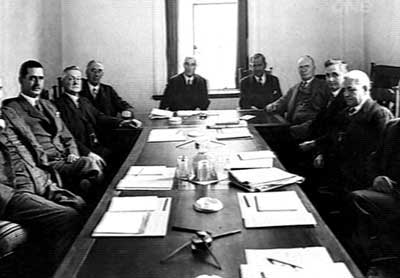
(T.W.Ratana) “I have the papers here containing the signatures of the people who swore to support me, 38,000 of them. I hand these to you also. I do this although I know you are not the Government, but in the knowledge that when you become the Government in 1934, you will already have received the seed; which are:
- The Treaty/ Tiriti Of Waitangi
- Te Mana Motuhake
- The Lands of Taranaki, Waikato, Tauranga, and Tai Rawhiti that were plundered or confiscated
- The claims of the people of Ngai Tahu
- The funds set aside for the Maori returned servicemen of 1914-1918 War
- Rating and Taxation
- Lake Taupo
- All other cases that may be bought forward by the Maori people under the Treaty of Waitangi.
The list of grievances were handed over to Mr Holland, a slight murmur echoed across the Marae, debates between different Maori elders were signalling their request for compensation in monetary retribution, however the people from Waikato, Tauranga and Tai Rawhiti voiced their view, money will not compensate for the blood of their people that was shed in the fight to keep their lands.
A petition from Ngai Tahu was also added to the list concerns relating to land claims. Several cases concerning leases were tabled relating to Maori people were not paid lease or rent by the Pakeha tenants, in this case suggestions were bought forward that instead of their debts growing bigger it would be much better that the Maori people be given back possession of their land. However the Government did nothing to solve these problems.
(Editor WM Paikea P, 1932: pp8-15; Akoranga, Anaru, 1997: pp77-80)
There were many factions both Maori and Pakeha jealous of the Ratana Movement and Ratana Church, Morehu were denied certain benefits such as pensions, all these issues were forwarded to Mr Holland. The people who witnessed this occasion were the eyes and ears of the people throughout the land, the blacksmith, carpenters and the shoemakers, the ordinary people. Mr Jordan MP agreed that the Treaty is treasured by the Maori people; but has been trodden upon and disregarded by the Government, right from the beginning, down to the Government of this time who build barriers to stop Ratana’s wonderful work. The powerful speech delivered by Mr Holland with the aid of translators P.K.Paikea. He acknowledged all who are present on the Marae also greeted the 4 Maori Members known as (Nga Koata) who he described as the sons of Ratana. Mr Holland said that many Pakeha who know of your concerns for the Treaty of Waitangi which Ratana has spoken of many times, if the Maori people remain divided they will not succeed in their quest. The Maori people have to unite as Ratana mentioned in his many of his speeches, then it would be far easier for them to reach their goals. Mr Holland expressed that New Zealand was suffering from an economical slump due to a shortage of money and that there is a petition being launched asking the present Government to resign. Even when T.W.Ratana travelled overseas on his first world tour, he travelled to Geneva where he found out that the Maori people were not represented on the League of Nations. The League of Nations recognises the Maori people as a Nation. (Akoranga, Anaru, 1997: pg59)
Tirikatene Enters Parliament
Members of Parliament for Southern Maori by-election for the seat were held on the 3rd August 1932, as T.W.Ratana offered his Koata, Eruera Tihema Tirikatene, for election. These results were published where Tirikatene was voted into Parliament and would carry the flag for the Treaty of Waitangi on behalf of the Ratana Movement and Church. The Morehu rejoiced over the victory of Tirikatene’s win into office. T.W.Ratana (Mangai, Piri Wiri Tua) rejoiced for the Morehu, they finally have voice in a Parliament. This move would allow their Candidate to promote discussions, make decisions in the House of Parliament as there were many laws still affecting the Maori people. Ratana’s long campaign to have his candidates elected into the four Maori seats began taking shape. His first candidate Eruera Tihema Tirikatene although elected in a by-election he still won the seat by a margin. The following results in the by-election stands.
Eruera Tihema Tirikatene (Ratana Independent Party) 425
W.T Parata (Coalition) 184
P P Makitamara (Independent) 184
J Beaton 132
T.K Bragg 94
Wiremu Mihaka 03
(Akoranga Anaru, 1997: pg86; WM Paikea P, 1932; Henderson, 1963: pp91-92)
When Eruera Tihema Tirikatene and his family visited Ratana in 1921, with Ratana noticed his multiple skills. Mr Ratana asked Eruera to stay, he predicted that his career would be fruitful and had a great future a head of him. Even after his election in 1932, he handed over his parliamentary pay to the Ratana Movement according to a covenant imposed by the T.W.Ratana Mangai. His South Island family assisted with gifts of money and produce, their family at Ratana Pa knew what poverty was. For seventeen years Tirikatene was one of Ratana’s closet confidants and his skills were unquestionable. Tirikatene became the candidate for Southern Maori, which T.W.Ratana (Mangai-Piri Wiri Tua) bestowed upon him the name “Te Omeka” (Omega). The name Omeka had special significance within the Maramatanga signifying the biblical name in scripture to the fulfillment of Jehovah’s great plan bestowed upon his servant T.W.Ratana.
(Kara Book Pene K, 1990: pg18)
On September 20th 1932, T.W.Ratana and his followers departed for Wellington. They assemble at the home of Te Heuheu Tukino at Lyall Bay. During one of Ratana’s speeches he said to both of his Koata,
“You have been ordained that you occupy the position you have in parliament. I place upon your head the Holy Spirit, and ask that the Faithful Angels be with you also. You will be required to swear an oath of Loyalty to the house and the Law. Take that oath, you have already made. In all of what you say, and do, don’t forget Jehovah.”
He then turned to Paraire, shook his hand, and spoke the following words.
“You have been a Ringaringa and Waewae for over six years in the works of the glory of God. Tena Koe, (greetings to you), go as a helper and companion for your colleague Tirikatene. Your job will be to observe and listen; to study what is being planned in Parliament. In the past your job was to record on paper what was being said. However, today I give to you the Maramatanga that you will be able to record in your mind whatever you hear or see; I also endow you with the Mauri (life source) required for this work. The Faithful Angels will ever be at your side.”
Paraire Paikea was recognised by Parliament as Tirikatene’s Secretary and Interpreter, and in this capacity was permitted to sit with Tirikatene in the debating chambers. After Tirikatene and Paikea left T.W.Ratana Manga addressed his Apostles, and spoke these words.
“I liken those two men to the two angels that were sent to Sodom and Gomorrah, and the two scouts that were sent out into the land of milk and honey. Soon we will hear an explosion at Sodom! In the scriptures, the two Angels were spirit, but today, the Angels are physical; why is it? Because they are both servants of the spirit.”
It was on the 29th of September 1932; Eruera Tihema Tirikatene delivered his maiden speech in the house of Parliament. This speech was record by Paraire Paikea.
(Editor WM Paikea P, 1932: pp2-8; Akoranga, Anaru; 1997, pg87)
(1932) Eruera Tihema Tirikatene’s Maiden Speech
“Mr speaker, I wish, if I may, commend you and your deputy speaker, for the able manner in which you both conduct the business of the house according to standing order. I wish, also to commend the mover and seconder of the address in reply debate for their contribution. I am but a new leaf sprouting forth among members of this house, thus I stand at the time to deliver my maiden speech. Although I have been here in the house for but a short time, I have learnt that, in order to survive here, one has to have diligence willing to participate in the debates and expert in extricating oneself from awkward situations during those debates.”
“I have been elected to this house as an Independent with the express purpose of looking into winning back the rights of the Maori people. My party is the Ratana Party, a name that is on the lips of the big and of the small of this land and of many overseas countries.”
“My Platform or policy involves the rights and Privileges of the Maori people as embodied in the Treaty of Waitangi. However, I do not intend to elaborate on this at this time, but will do so in the fullness of time. There are certain other matters which I want to deal, Sir”
‘Unemployment: Other members of this house have talked about unemployment. I agree, unemployment is seriously affecting both Pakeha and Maori alike. There are many members of this house who do a great deal of ease the plight of the Pakeha unemployment. I therefore ask that those same members should give some thought to us, to the Maori people; let us work together that we might make some progress in this.”
“So far as the Maori is concerned, unemployment is a very difficult matter to address. It seems to me there are two laws, one for the Pakeha unemployed and one for the Maori unemployment! It has been decided that the Pakeha may pay a tax that will entitle the payer to be considered for employment. This is not the case where the Maori is concerned. A submission has been made asking that Maori be treated in the same way as the Pakeha, so that the Maori may also have the right to apply to the Board for work. If a Maori is found to be unsuitable for whatever work that may be available, he is told to stand down, although he has paid a tax.”
“ It is then that we will have to seek ways and means whereby he can support his family, or else simply depend on others to help. It was not long since I was unemployed. I filled in a form applying for work, and was given a job. Two days after I started work, my boss found out that I had not paid the tax. I was promptly discharged. This did not worry me. However, a day later, I was recalled because they were unable to find anyone who could do the job.” “Although many of our people are unsuitable for some of the work offering, it does not matter, as we find it easy to adapt ourselves to any kind of work. I also want to mention the position regarding Maori Women who are not being considered for employment. I ask the Employment Board give consideration to providing work for Maori Woman.”
“Pensions: "It is said that the government is considering reducing the Pensions for the aged. Let me say that although our senior citizens are getting older, it doesn’t mean that they will be eating less. If Government reduces the age pension, then it will be effectively reducing the amount of food on the tables of the aged. This is applicable to both Pakeha and Maori.” “When Pakeha came to New Zealand, the land was covered in bush. They developed the land so that we have what we see here today. Perhaps some of my Pakeha friends will say I am being unreasonable when I say, the Maori people should not be some of t the practices of the Pakeha. I know some of them would kick me for saying this. But let me put it in this way- Our Pakeha friends are hundreds of years ahead of the Maori in far as science, technology and education may be concerned. They have therefore, the ways and means of providing for their age of retirement. It is not like this with the Maori people.” “I therefore ask that consideration be given to reducing the age of retirement.”
Petitions:“I want to refer briefly to the matter concerning petitions that have come into the house from time to time. There have been many petitions, but very few have investigated, and most of them have never been dealt with at all. These petitions contain a most sad but worthy request, and it seems from what I understand, the people receiving those petitions on behalf of this house are in no way at all conversant, or sympathetic with what the petition really mean.”
Rates and Taxes: "The manner in which the Maori people are being forced to pay Rates and Taxes saddens me greatly. Large areas of Maori land have been taken by proclamation due to the fact that rates and taxes were not paid. This is a practice that seems to follow for one reason alone, and that is to get Maori land without paying for it. Its seems this is being done even although it is known that the Maori should not be paying for it. It seems this is being done even although it is known that the Maori should not be paying rates and taxes, and further these matters should be thoroughly investigated.”
The Electoral Act: “Although I have been elected to this according to the provisions of the Electoral Act, there are many parts of the act about which I am not happy. I want to refer especially to that part of the act, which governs the work of officers in charge of polling booths. In respect of the Elections for Maori candidates, the officer and his assistant are supposed to work strictly according to the Law as laid down in the Act. However, it seems they have their own interpretation of the Law. This leaves a lot to be desired.”
“Some months ago the leader of the Labour Party asked that Maori Polling Booths be conducted in the same way as Pakeha booths, but nothing was done. In the case of Maori, when a person goes into the booth to vote, he or she, is asked for whom do you want to vote for?When the electors answers, the officer writes down the name of the preferred candidate. The voter then leaves the booth! At the last elections, there were two of us candidates whose names were similar, Tirikatene, Wikatene, and myself. This similarity of names can cause mistakes. This way of voting should be changed. Further, this may be averted if scrutineers were permitted to be present during voting hours.”
Schools: “I want to make a brief mention concerning of schools. There have been many of our Maori children who have gone to schools, colleges and other institutions, and who have spent many years educated, with the view of being properly equipped to receive work in Government Departments and other such work. It seems they have wasted their time, for they are not considered at all. I ask some thought given to making use of the education these children have received. There are many of our children who have gone through secondary school but have not carried on to university because lack of money for their education. They have sought monetary assistance in vain.”
“As I bring this, my maiden speech in this house, to a close, I hope I haven’t touched on any matters of contention that members may wish to follow, or contest. I hope to be able to elaborate more on the matters I mentioned today at some future date, as well as speak at some length on the Rights and Privileges of the Maori people as embodied in the Treaty of Waitangi” (Editor WM, Paikea P, pp2-8: 1932; Akoranga, Anaru; 1997, pp88-91)
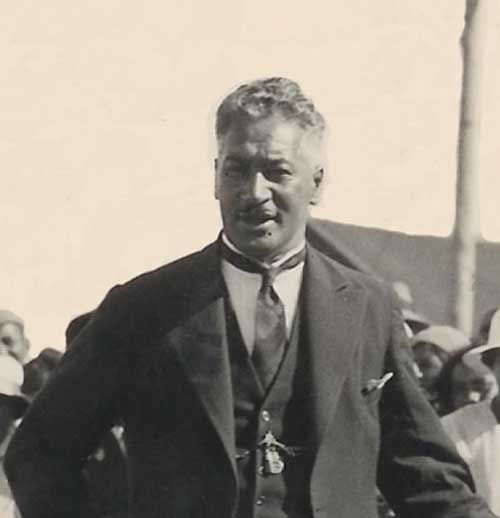
After Tirikatene finished his maiden speech quite a number of M.Ps rose to congratulate him, and to follow on some of the matters he had raised in his speech. During the end of December Ratana gathered his Morehu living in Ratana Pa, he told them that he would be putting another covenant together, and he noticed that some people living in the Pa were going to refuse to sign his covenant. After the covenant was written up he began to read the covenant to his people. In his covenant he vowed that he would not allow, or agree that anyone else should complete his work; it was I who started it, and it will be me, (spiritual talk) myself who will finish it. The matters of the Treaty of Waitangi were still being discussed especially in Waikato. Mr Ratana himself worked to ensure no stone was left unturned in the work of the Tiriti O Waitangi.
Many of the great Maori leaders had tried so hard to have the Tiriti ratified saw Ratana as their last hope for Maoridom. The political advance for the Ratana’s structure differed from Ngata and Pomare, and also from Carroll and Heke. Ratana platform would be an example in the bringing about the ratification of the Tiriti of Waitangi. During October 1932, Maori leaders from around New Zealand, who are direct descendents of the leading chieftains, gathered to support Mr Ratana. They were camped at the home of the late Hon Mr Te Heu Heu Tukino at Lyall Bay. They were in Wellington in connections with the rights for Maori under the Treaty of Waitangi. There were a royal list of descendents who were present at the house Te Heu Heu Tukino, descendents from Te Rauparaha, Te Rangihaeata, Te Whitu Tohu, Titokowaru, Te Kooti, Hongi Heka, Potatau, Te Whero Whero, Potangaroa, Te Maiharoa and others were gathered to support T.W.Ratana and ratification for the Treaty of Waitangi (Dominion Photo: 7th October 1932).
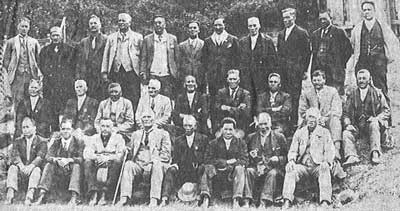
During 1933, T.W.Ratana revamped his two main committees Ture Tangata under Piri Wiri Tua who would be responsible for administering affairs within the Pa as well as dealing with Ture Tangata matters that may be sent from outside the Pa. The church committee under T.W.Ratana Mangai would be responsible for dealing with all Church matters throughout the land.
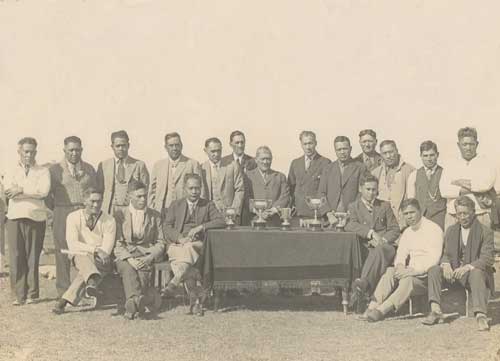
The aim of Mr Ratana is to have four Maori Members represent the Maori people in Parliament who would support and work for the Treaty of Waitangi. Mr Ratana’s message to his people on new years herald a sad and difficult time ahead for them. His message he delivered to his flock, in times ahead have courage, and be loyal, each one of you must bear his or her own cross. If you see your cross is falling re-adjust it. He continued by saying the manner in which you bear your cross will determine whether you will meet with good or bad.
The day is coming when the tail will become the head and the head become the tail. The people looked in fear as Ratana continued to express the hardships that would be approaching in the near future. He continued by saying if anyone should arise among you to preach to you, in the near future beware for that one will have the devil with him. You will see signs of the weeds and thistles that have been left behind by the weeder.
During 1933, Ratana attempted in building a University/School at Wai O Turi, near Patea was unsuccessful. He was trying to build a Tiriti University, which dealt with the content written in the Tiriti O Waitangi, and also to produce the highest quality of Maori workmanship from every arena (Akoranga Anaru; 1997: pg112; WM Tane M: 1933)
The death of Te Rata the Maori king ripple throughout Maoridom, Ratana was sent a message from Te Puea Herangi and Hanunui Tawhiao Ariki, asking if he would attend his Tangi. Once Ratana arrived on the Marae led by the Ratana Band, he stood up to give his condolences to the bereaved family as a moment of truce echoed across the Marae, when all of a sudden he was interrupted by a man named Tutaneki who yelled out, who gave you permission to speak first? It is I who should speak first, not you.

“I am greeting the dead, Te Rata, not you, the living. It is because of this man lying here that I have come to this place; I am paying my respect and saying farewell to him, not to you. Further, it was not you who asked me to come here.”
One of the Kings family called out "continue on Ratana with your korero (speech), nobody has the right here to stop you, and the man who interrupted you is not one of ours, we do not know him. He is from Te Arawa, so speak on.
After Ratana finished his speech orators from the Marae rose to reply and to welcome Ratana and his people.
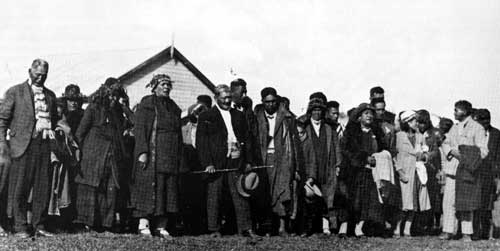
During October, Koroki was ordained as Maori King by the Clergyman of the Anglican and Methodist churches. After the ceremony, the Marae was open for general discussions. The discussion arose about the Treaty/Tiriti with Mr Ratana speaking on the significance of it; with the majority of those who followed spoke in favour of what Mr Ratana said. (Editor WM Tane M, 1933: pp3-4)
In 1934, king Koroki visited Ratana Pa T.W.Ratana gifted to him three Taonga a ring, a carved walking stick and a Maori feather cloak. He said to Koroki I give you these Toanga in the hope that they will serve as a reminder to you in days to come of our meeting and of your coming into the Temple today. An elder from Waikato by the name of Te Kiri Katipa spoke to the people he translated the interpretation of the Taonga to those gathered. The meaning of the Maori cloak represents Maori sovereignty, the carved walking stick represents spiritual power, and the ring represents a Marriage between the two people. These two people are the Ratana people and Waikato people. (Akoranga, Anaru, 1997: pg115)
T.W.Ratana (Mangai) continued to speak the prophesies of this land, of Potatau, Tawhiao, Tohu, Whiti, and the others saying, “I have them all in the palm of my hand”; the Wa (time) already ordained that you should come here koroki that is why the wa and I persevered so long ago. Ratana said that I do not blame Waikato for taking so long to make up their minds for what happened in the past was meant to be, the right time for this to happen has finally come.
(Editor WM Tane M, 1934: pg4)
(5th July 1934) T.W.Ratana, Piri Wiri Tua
While in Wellington T.W.Ratana visitied Parliament House with his senior members of the Ratana Church, Mete Keepa and Tirikatene and other Kaumatua and kiua. As they were entering into Parliament House, Ratana saw the Coat of Arms at the top of Parliament that had the emblem of the Tiger and Lion. He looked up at the emblem N.Z. Coat of Arms and began speaking to it.
"E te Raiona nei me te Taika, me te Karauna, he tohu nei koutou no te Emepaea o Ingarangi, ka tu nei ahau i runga i a Koe, a, ko koe hoki te mea Kaha; taku kupu, kia puta mai ano te mea reka i roto i a koe ki ahau, ara ki te Iwi Maori, otira ki te Iwi Morehu".
“O Lion O Tiger and the Crown, you are the symbols of the British Empire (England), but on this day I stand upon you, and as I stand before you, you are stronger than I. I say to you, let there be "sweet Fruits" for me (my Maori people) from you"
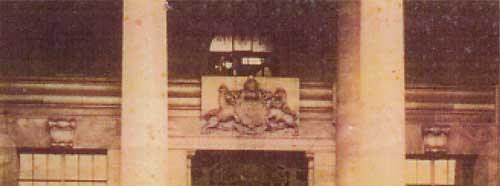
As he continued to speak to the chair in which the Speaker of the House sat he said to the chair of the speaker:
“To you the seat, I great you, for upon you sits the person who shall pass laws for me whether they be good laws for all the seats that are here, for upon you sits upon those who deliberate and decide my future for me”. “My word to you, say to those and to the policies and principles that are sitting upon your seats that you must do justly right justly”.
He continued by saying to all the members who were sit in the seats in the chamber to do their work well and fairly, and asked them not to permit the passages of laws that would impinge or hurt the Maori people, and if this is done, the root of the tree would wither and die (Me Pa-te-Titaha) and when the wind comes the tree will be blown away to be consumed by fire until only the ashes remain. T.W. Ratana Mangai planted the Geranium flower within old the parliament grounds to signify the Tiriti O Waitangi, which at a later date he would return to claim. (Symbolic for the Tiriti O Waitangi). T.W.Ratana spoke in parables to the congregation who were listening. Further he said to the members of Parliament:
“Greetings, greetings, greetings, to the chair in which Tirikatene sit. I pray that you and your occupant will have courage and strength, so that the work your occupant does will shine brightly over this land.” (Editor WM Tane M: 1934)
Later, T.W.Ratana Mangai Piri Wiri Tua arrived at the Upper House where they again sat on the chair of the speaker. He repeated the words he had spoken in the Chamber, he warned them to take heed of what he had said. In the Maori Affairs room he sat of the seat of the Chairman, again repeated what he said in the Lower and Upper chamber. The clerk placed before Ratana the documents, the claims of the Treaty of Waitangi and Te Mana Motuhake. These document were actually the same documents that T.W.Ratana Mangai and Piri Wiri Tua had sent that explained the Sacredness of those contents of the Treaty of Waitanga.
After the speeches were conducted Mr Ratana rose and said: “O rain, fall upon this Parliament, let water spill upon it, so that, what I say, may be blessed and carried out” (Editor WM, Tane M: 1934)
Throughout the years Ratana’s Ministry still attracted more followers from every part of New Zealand. Many of these people brought with them their own beliefs and therefore much theological dispute arose among those gathered during the fellowship sessions. Despite such minor setbacks, the membership of the Ratana Church grew. Ratana’s long campaign to have his Nga koataelected to the four Maori seats in Parliament was still a reality to the Morehu and Ratana himself.
(Go to History Page)
T.W.Ratana (Mangai) and his Roopu once again travelled back to the South Island, an invitation given by the people of the South Island tribes. They travelled by the Steam-Ship “Maori” from Wellington and landed in Lyttelton. While in Temuka a rugby match between North Canterbury and South Canterbury was played for the T.W.R Challenge Cup Sports Trophy, with a hockey match being the curtain raiser before the main event. On the 17th August 1934, the Ratana flags arrived in the South Island and were taken to Tuahiwi. Te Aika head of Ngaitahu Runanga, Waata Moumou gifted a Cup to Ratana (Turakautahi Cup). Healings were conducted by T.W.R Mangai that night, followed by the Ratana concert party performing in the picture hall at Tuahiwi. On the 18th August 1934, Mr Ari Pitama and his party were waiting for T.W.Ratana Mangai to arrive in Christchurch. Ratana’s concert party were due to perform at the Christchurch Winter Exhibition to an audience of 6000 people. The next day Ratana continued his tour to Rangiora and Waiwera. On the 29th August 1934, Mr Ratana and his party arrived back in Ratana.
On the 6th September 1934, T.W.Ratana Mangai and his Roopu returned to the South Island travelling by the Steam Ship Rangatira arriving in the West Coast of the South Island. They travelled to Poutini, Aorangi, Arahura and Hokitika where they visited the Haangi Marae. They were greeted by the South Island Kaumatua and Kuia Awhina Mason, Rore Tauwhare, Iraia Tainui, Ema Tainui, Tipare Meihana, Kohere Weepe and Tuhuru Tainui in Arahura. Two green stone from the Arahura River were gifted to T.W.Ratana (Mangai). Both green stone were lodged in the Archway leading into the Temple at Ratana Pa. They continued to Lake Kaihinu, known for its small eels hence the name “To eat Fat”. They travelled to Lake Kanieri the Power Station and the Bottomless Lake. On the 10th September 1934, Ratana visited the Caves at Mawherae Greymouth for a memorial service, where elders of Arahura were buried. The last chief buried in the cave was Tuhuru, ancestor to Poutini. (Editor WM Tane M, 1934: pp2-11)
Work had proceeded with the clearing of the site for the Memorial Archway in 1934. The memorial was being erected for the South Island Maori who fell in the Great 1914-1918 War. However, part of the Oamaru stone for the arch had arrived, and plans to start the work would be laboured by Maori craftsmen from the North Island. There had been many delays to unveil the memorial some issues resulted in the court forbidding the unveiling due to the raising of finance for the project this resulted in the court forbidding the unveiling for another six months. Permission was finally granted in August 1934, for the ceremony to proceed, and the time taken up in negotiating an appropriate time for T.W.Ratana to unveil the monument. (Timaru Herald November 14th 1935)
Although the Temuka Archway opening was cancelled in 1934, this gave Ratana the opportunity to open the Memorial Arch which stands in front of the Temple at Ratana Pa. This Archway was unveiled and Consecrated on July 5th 1935. During the opening of the archway Ratana spoke with compassion and love, this became evident as the people who were gathered round the archway were overcome with ore as he spoke the final part of his speech to opened and consecrated the archway.
Ratana and his party comprising 68 members travelled back to the South Island arriving at 1.30am by car from Ashburton. They were received by 40 local Maori at the Arowhenua hall. Runanga member Mr N Waaka, the chairperson, welcomed the visitors to the hall. Visitors from Tuahiwi, Morven, Glenavy and Moeraki were also present at Arowhenua. Ratana and his Roopu were in Temuka to unveil the Arowhenua Memorial, but due to rain the unveiling was postponed. On Tuesday evening a concert and dance was held for the people.
Eruera Tihema Tirikatene was conducting his political campaign and the visitors included Tiaki Omana and Paraire Paikea Ratana candidates for Eastern Maori and Northern Maori, (Nga koata). Tirikatene delivered his speech to the Maori electors and was supported by the Rev Clyde Carr.
The Temuka Archway was finally open on the 13th November 1935, to commemorate the Ratana Movement and Ratana Church, to Ratana's sons and to the Memorial to the Maori killed in the 1914-18 War.
Ratana delivered his speech to the congregation and Eruera Tihema Tirikatene gave tribute to the people for the erection of the monument to the tribes represented from the four winds of the earth commenting by saying: “Let us be grateful” T.W.Ratana’s official greeting was read to the people by Eruera Tihema Tirikatene: (Roll of Honour). (Timaru Herald, November 13th 1935: pg3)
Te Timatanga Me Te Whakaotinga Te Arepa (Second in House) 1935-1944 Haami Tokouru Ratana (Te Arepa) The eldest son of the founder of the Ratana Established Church of New Zealand T.W.Ratana. Tokouru stood as Ratana Candidate for Western Maori against Sir Maui Pomare in 1922 and 1928, and in 1931, against Taite Te Tomo. He defeated Te Tomo in 1935, with a majority of 48 votes. He entered Parliament as a Ratana Independent Party Member, later he would contest the seat for Labour in 1938, and held it until his death on 30th October, 1944. He was also the First Member of The Ratana family to lead the Movement and Church after his Fathers death.
Te Takawaenga Piriwiritua (Third in House) 1938-1943 Paraire Karaka Paikea (Piriwiritua) He became Chairman of the Ratana Church Committee and succeeded to the post of private secretary to T.W.Ratana in 1928, when Peter Moko resigned. Paikea was Secretary for the Ratana Kotahitanga Welfare Association. In 1928-31-35, Paikea contested the Northern Maori Seat as Ratana Independent against Tau Henare but was unsuccessful. In 1938, he defeated Tau Henare by 2,011 votes and entered Parliament as Labour Member for Northern Maori. He became Secretary of the Maori Advisory Council of the Labour Party in 1936, and became Minister representing the Maori Race. In 1941-43, he was a member of the War Administration Board as Maori Recruiting Director, and was the architect for the Maori Social and Economic Advancement Bill, which became an Act in 1945. Paraire passed away 6th April 1943.
Te Tatou Raua Ko Te Puawaitanga Hamuera (Fourth in House) 1943-1947 Tiaki Omana (Hamuera) When Mr Omana was made a "Koata" in 1933, T.W.Ratana said this to him; "Tena koe e taku tamaiti e Tia (short for Tiaki) ka inoi ahau ki a IHOA kia pai te tupu o tau maara kerepe, kia tu te waina ataahua ki runga ki tau teepu; ka hoatu e ahau ki a koe te kii o te raka o te tatau". Translation; - "I greet you my son Tia.... I shall ask Ihoa that your vineyard will be fertile and that your grapes will flourish so that wine of the finest vintage will be set upon your table; I give you the key of the Lock of the Door.” Mr Omana stood as Ratana Independent in 1935, Ratana Labour Independent in 1938, when he failed again because the number of candidates representing Labour interests. When he left he defeated Sir Apirana Ngata, and took his seat in 1943. Tiaki Omana moved the word Maori to replace the word Native in all Government Titles.
Under Construction to be continued
| |
|
|
|
| |
||
|
|
